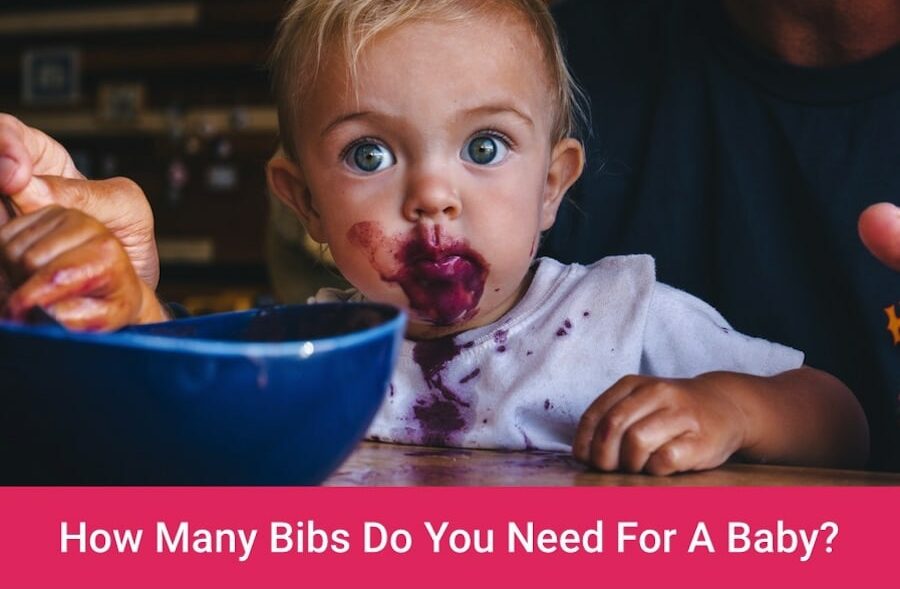
Article By Edna Skopljak – Medical Doctor (MD)
When you are expecting a baby, the list of things you need to get can get pretty long. From baby’s clothes, strollers – to baby bibs and toys. Really a lot of it, right?
Although it’s exciting, to prepare for your little baby, sometimes, you can get overwhelmed and unsure about what you really need to buy, how much is enough, and so on.
Drool bibs and feeding bibs are baby must-have accessories. They protect your baby’s clothes and their sensitive skin from foods or drinks accidentally spilled during the meal, or the inevitable baby drool.
Babies are not only cute, babies are messy, too! Keep that in mind. And you surely need bibs. The only question is – how many bibs do I need? Is a single bib enough? And how many bibs are enough bibs?
Besides, there are so many other questions, from which type of bibs are best, to how to when to start wearing them. You will find all those answers in this article, so make sure you read it until the end. I believe you don’t want to end up with too many or too few bibs (or even wrong ones).
This article is not a substitute for medical advice or consultation.
What Bibs Do You Need For Baby? – Drooling Bibs & Feeding Bibs
Baby bibs come in different materials and designs. And – they have different purposes. Bibs are divided into drool bibs and feeding bibs. So, even though you may think you don’t need bibs for newborns, the truth is – you do!
Even a small baby can still make quite a mess. Baby drools a lot, let’s face it, and it’s definitely easier to change a bib rather than the whole baby’s wardrobe. Babies also spit up quite a lot, so, again, bibs (drooling bibs) are pretty convenient, right?
Once your baby starts eating solid foods, you will surely need bibs. And you will need more of them. Starting solids can bring up a lot of mess. So, to make your life with a messy eater easier, having a bunch of feeding bibs will be a good starting point.
But, what is the difference between these two types?
Firstly, drool bibs are smaller than feeding-time ones and their main purpose is to keep the front of your baby’s outfit and skin underneath dry.
The drool bib is just large enough to cover the baby’s upper chest and neck.
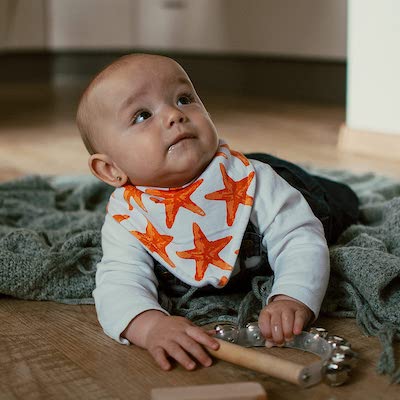
On the other side, feeding bibs are typically larger than drool bibs. They offer wider coverage to protect your baby’s clothes and skin on the upper chest and shoulders (sometimes even arms and stomach!).
Secondly, drool bibs are usually made of absorbent fabrics that wash easily and dry quickly. This includes fabrics like flannel, heavy cotton, and even bamboo.
Also, most drool bibs are cloth bibs that have two layers. However, feeding bibs are made of waterproof or almost waterproof fabrics – mostly silicone. So, feeding bib is easy to wipe off or clean after their meal.
And, there is a difference in style. Since drool bibs are meant to be worn all day, they usually fit snugly.
When Do Babies Start Wearing Bibs?
Babies can start wearing bibs whenever it’s necessary. And yes, this applies even to those babies who are not yet eating solids – or who are not teething.
Newborns actually may spit up a lot, so you would benefit from having a bib. However, make sure you use an appropriate, newborn bib in this case, for safety purposes. Newborns have small airways, so even burp cloths may block them.
However, most moms decide to introduce a bib to their baby once they start teething, as that’s the point at which the baby actually starts drooling more.
How many bibs you need depends on several factors – keep reading the article to find out more.
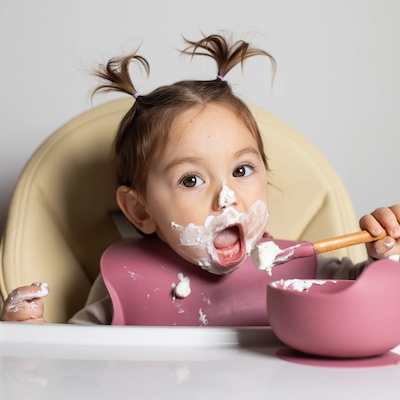
Do You Need To Buy Bibs For Newborn Baby?
Actually, it is better to have it even for your newborn. Yes, you’ve read well. Even newborns could use some extra protection, as they spit up during feeding.
These (newborn) bibs are extra small and designed to fit your baby’s neck preventing the rashes that may form due to extra moisture, before they can hold their own head up.
Newborn bibs are great for little ones not older than six months as these bibs are more of absorbent material and easy to take on and off.
You may now think – how many bibs do I need in this newborn phase. The truth is – you don’t need many bibs in this period. Three bibs are enough.
Does A Baby Need A Bib When Breastfeeding?
During feeding (and breastfeeding), little babies tend to spit up. Therefore, wearing a bib could be beneficial in this case. Your baby’s outfits (and you) would be safe from extra round of washing.
Using a bib, even a soft cloth, ensures you and your baby stay clean and dry during breastfeeding.
How Many Bibs Do I Need?
And, now we come to the question from the article’s title – and probably your main question when you are buying things for your little one: How many bibs do I need?
Of course, the number of bibs you need depends on you and your baby. For most younger babies and newborns, a few bibs should be enough. For babies that occasionally drool or spit up, you would need more bibs to last the week.
This number of bibs you need increases with age, as your baby grows. Let’s say it peaks from six to twelve months, as this is the time they start eating solids and when they’re teething (read: a lot of baby’s drool).
So, you will need more of both – feeding bibs and drool bibs. That is the time you will need bibs the most. Having at least ten bibs of both types is a great start.

When the baby passes their first birthday, you will probably need fewer drool bibs, and you will increase the number of bibs for feeding. That’s the time they independently eat solid food. In other words, they become messy eaters.
My tip in this case, is that you get smock bibs. Smock bibs are also known as the “long-sleeved bibs”. They are worn like a shirt that tends to go down to the knees. And you will love this full-coverage bib.
On average, three to nine bibs per child are optimal. This, however, depends on several factors, including feeding, drooling, and laundry schedule. Bibs need to be washed similarly to burp cloths. In other words, a higher number is more desirable. More drool bibs is a must.
If you want to be sure you have enough bibs, make sure you get at least 10 cloth drool bibs and 1-2 feeding bibs for when they start solids.
At What Age Do Babies Stop Using Bibs?
Using drool bibs doesn’t make sense after your baby turns one and a half or two years of age. That is the time their oral muscles are developed enough to control their drool. As for the feeding bibs, your baby will need it into their toddler years, for the multiple meals they eat themselves.
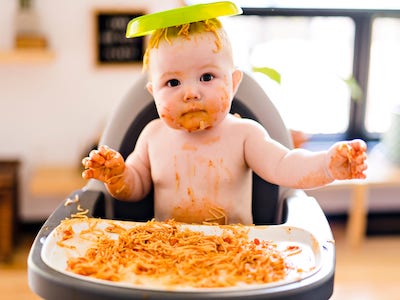
How To Choose The Right Bibs
Choosing the right bib for your baby depends, as we already said, on several factors. I will briefly present you the most important ones, and also what to look for on your bib.
Feedings
The frequency of your baby’s meal, or how often your baby breastfeeds or drinks formula can drastically increase the number of bibs you need throughout the day.
It is especially truth if you use a new bib for each feeding, either because the baby gets messy or because the baby dribbles out milk after every feeding.
Dribble bibs and cloth bibs are great examples of a feeding bib in this first period, before they start solids. Later on, you will switch on silicone bibs and a traditional bib for a baby that eats solids.
If you are baby lead weaning, the things can get more messy, so you would benefit most from smock bibs (check my list of the best bibs for BLW in this article).
If you love to travel, buying disposable bibs is also an option!
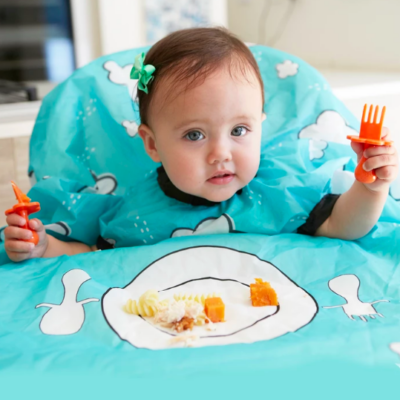
Drooling
Even before your baby starts teething, some babies drool – A LOT. And once they start teething, it gets worse. If your baby is a heavy-drooler, you already know that it’s easier to replace a wet bib than an entire outfit.
In this case, choose a bib that is absorbent enough, but also that is made of natural fabrics. Ideally, and especially for a baby’s sensitive skin, organic muslin is a great idea.
Laundry Schedule
How often you wash your baby’s wardrobe (including bibs) will surely influence the number of bibs you need to have available at any moment. See how many bibs and burp cloths you need per day, and how many times you turn your washing machine during the week. This math will guide you in the process of choosing bibs and burp cloths and give you the answer on how many bibs to buy.
Material
We always want the best for our little ones. Materials of anything they come in contact with are important. Also, having materials that match the needs is crucial.
Drool bibs are usually cloth bibs made of some type of cotton. Cotton is absorbent enough and good for your baby’s skin. However, if your baby has extra sensitive skin, organic cotton – muslin, or some type of hypoallergenic material is desirable.
For babies that are ready to start BLW and solids, having plastic bibs or silicone bibs is great, as these are extra easy to clean – and reuse. A clean bib is sometimes an easy thing to accomplish.
Tightening And Closure
Some babies don’t like to wear bibs. And, although little ones are not likely to be strong enough to pull off a bib with a hook or loop, it is better to be safe with having a bib with snaps, especially with older babies. Many bibs are designed having that in mind, to keep your baby clean.
Style
Traditional bibs are just right for mealtime, to serve their purpose. However, if your baby drools a lot, and you wear bibs most of the day, you may want to style your baby up – let’s say with bandana bibs. Bandana bibs make your baby’s outfit extra stylish (and cute).
Cuteness
Bibs are actually part of your little one’s outfit and appearance. Choosing some cute prints with matching colors and styles will be an added value to their cuteness. How many bibs of cute teddy bears, kittens, or flowery prints you will choose, depends only on you. While this may seem unimportant, keep in mind your baby will see their photos one day. And that you will also look at those photos every time you miss those messy times. Cuteness does make a difference.
Article By Edna Skopljak
Edna Skopljak is Medical Doctor (MD) who works in University Medical Centre in Ljubljana. She’s a She also worked as an editor at BJBMS medical journal for several years. She wrote content for several health-related websites and the BJBMS blog. She’s a mom of a 15-month-old.
The purpose of this article is informative. It’s not a substitute for professional medical advice or medical care. Remember: safety first! Consult your doctor/pediatrician in case of any doubts. The author of this article does not accept any responsibility for any liability, loss or risk, personal or otherwise, incurred as a consequence, directly or indirectly, from any information or advice contained here.
Resources:

